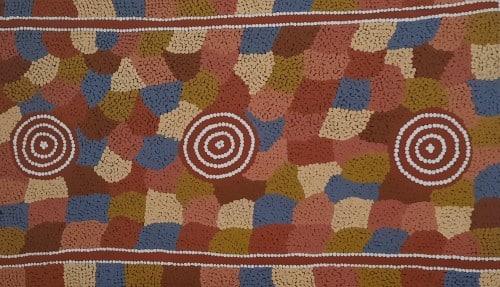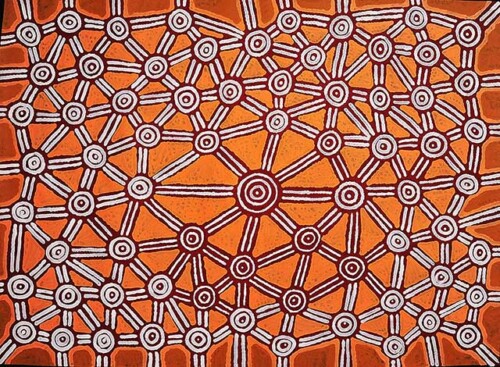Thomas Tjapaltjarri, born around 1964 in the Gibson Desert of Western Australia, was a member of the Pintupi Nine, known as ‘The Last Nomads’, Sadly, he died last week after being hit by a car – ironically on the 40th anniversary of his family’s emergence from nomadism in the deserts.
The family group consisted of four brothers (Warlimpirrnga, Walala, Tamlik/Thomas, and Yari Yari), three sisters (Yardi, Yukultji and Tjakaraia) and two mothers (Nanyanu and Papalanyanu). The boys and girls were all in their early-to-late teens, although their exact ages were not known; the mothers were in their late 30s. They’d lived a traditional lifestyle around Lake Mackay – almost certainly because their dead father Lanti had spent time briefly at Balgo Hills/Warrimanu but had left after being accused of stealing food – until their first contact with Western society in September 1984.
There followed a profound transition from this isolated existence to becoming celebrated artists within just a few years, a testament to their remarkable adaptability and the universal resonance of their cultural expressions.
Warlimpirrnga, of course, has become the most renowned artist, mastering the op-art dazzle that is much favoured by Papunya Tula Artists, for whom he paints. Yukultji is also a major artist with them. Oddly, neither Walala nor Thomas, who continued to live at Kiwirrkurra with their brother, joined PTA, but painted independently for galleries such as Japingka in Perth, Short Street in Broome and Kate Owen in Sydney. Thomas began painting in December 1987, exhibited from at least 2003, and frequently appeared as ‘The Tjapaltjarri Brothers’, or ‘Artists from the Indigenous Lost Tribe’.
A little corrective here. Neither WJ Peasley’s book, ‘The Last of the Nomads’ about a Mardu couple brought out of the Gibson Desert in the 1970’s, nor the Pintupi Nine were actually ‘The Last Nomads’. That honour belongs to the Spinifex Rictor Family who were found the Great Victoria Desert in 1986.
Another corrective – Thomas actually had a Tjapangati skin name, but seems to have seen benefit in being a Tjapaltjarri Brother. His art reflected the traditional Pintupi style, distinguished by simple, geometric designs and intricate dotting. Alongside his brothers Warlimpirrnga and Walala, and other notable artists like Willy and George Ward Tjungurrayi, Thomas delved into the stories of the Tingari cycle. These legendary Dreamtime beings, whose travels across the desert shaped landforms and ceremonial sites, give his work deep cultural significance. The multi-layered meanings of Tingari paintings are rooted in Pintupi ceremonial practices and body designs, offering connections to their ancestral narratives. He uses acrylic paints on canvas, sticking to earthy colours (red, white and ochres)
Thomas’s contribution to Indigenous art has been honoured in many exhibitions, including a prominent appearance in the Grande Experiences’ video extravaganza, ‘Connection – Songlines from Australia’s First Peoples‘ exhibition in 2022. His paintings are also held in collections worldwide, such as the Hank Ebes Collection in Melbourne, the Luciano Benetton Collection in Venice, and the Fondation Burkhardt-Felder Arts et Culture in Switzerland.







